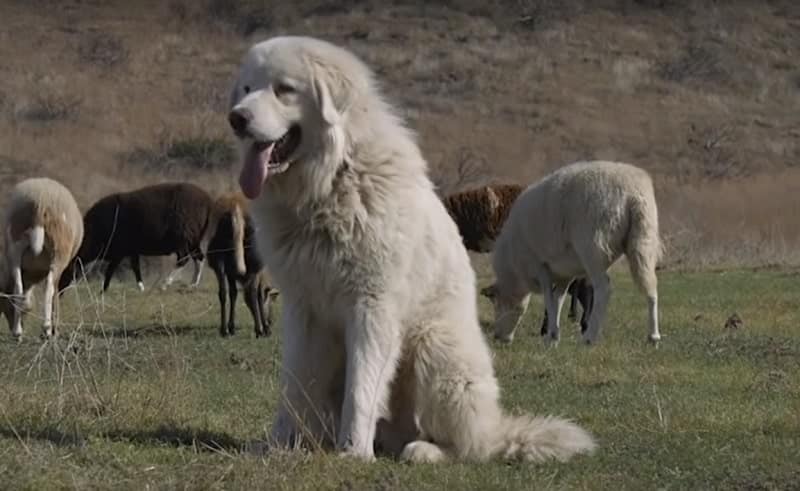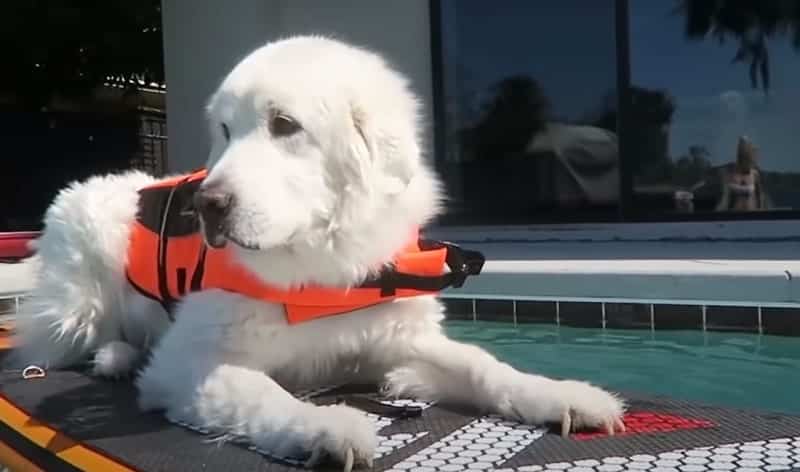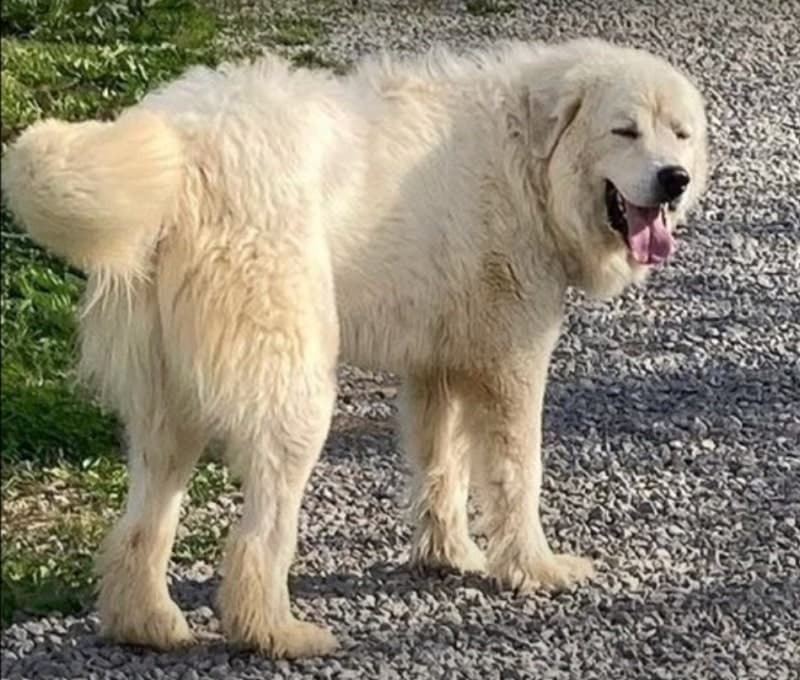- Do the Great Pyrenees Like Water?
- Can Great Pyrenees Swim?
- Are Great Pyrenees Water Dogs?
- Should You Let Your Great Pyrenees Swim?
- How to Teach A Great Pyrenees To Swim?
- Some Swimming Safety Tips For Your Great Pyrenees
- So, do Great Pyrenees Like Water?
The Great Pyrenees is a large and friendly breed of dog. They’re known for their good personality, which has made them so most popular among all breeds!
It is important to ask your vet any questions you may have about how best activities can be done with their dog.
The answers will depend on the individual pet and what they’re used too, but it’s good form in case anything goes wrong or new concerns arise!
Not all dogs like to swim. Some of them would rather play in the water or just lie on it than actually take off for a dip!
Just because your dog doesn’t seem to be interested in swimming, it doesn’t mean they’re bad at the water. In some cases, dogs might not have any natural instinct or inclination towards getting wet and enjoying a dip!
In today’s post, I will be answering the question: Do Big Dogs Like Water and Can Big Dogs Swim?
I have gathered all the useful information for you in this article, so let’s go!
Do the Great Pyrenees Like Water?

Before asking the question about can this breed swim, it is better to understand does this breed likes the water. Well, do they like getting wet? Is it a necessary activity for them in their everyday life (like playing outside), or is there something more special planned ahead of time? So, let`s discuss it first.
While some dogs have an absolute hatred for water, others are just unwilling to get wet. Otherwise, there are a lot of breeds, that love the water and have this passion to water from the very beginning.
Great Pyrenees are super durable dogs, which means they can handle just about anything. That includes being near or in the water without any problems at all!
Great Pyrenees love to play in the water and will most likely try their luck at jumping or paddling.
It’s always hard to tell what your dog is thinking, but if he likes water then it should be an easy decision for you.
If you make the experience enjoyable for your pup, they’ll be more likely to enjoy swimming in general.
Your dog might be more likely to get scared and bitten by the first time they go into rough currents, but if you start out slow with shallow water it’s not as bad.
So, I recommend you be gentle with your dog and let them explore the water on their own terms. Remember that they are probably still getting used to the feeling of being wet so don’t push it if they decide not to want to go in or find a different spot!
If the first touch with the water is soft, calm and together with the owner, it shows the best result in the future. Your pet will love water and swimming because it was not a scary experience from the beginning.
On the video, you can see how to make the first touch with the water, it’s best to let them go in a smaller pool so they can get used and comfortable with swim areas.:
Otherwise, if something went wrong and your puppy was scared, then it might take some time for a dog to get used to the water and to realize that it could funny and playful.
But, generally, this breed really like the water and to sim 🙂
Can Great Pyrenees Swim?
But what about their swimming skills?
It turns out that Great Pyrenees are actually quite good swimmers.
A herding dog is made to be active, and they have physical attributes that make them perfect swimmers.
They can go for hours in the water without getting tired or overheated because of their thick coats, and they don’t have any trouble trying to get back on land if you let them!
With their large webbed paws and powerful muscles, your dog can swim without any issues.
But, make sure you help your pup learn how to swim. They might have instincts for it but they will need some guidance too!
Are Great Pyrenees Water Dogs?
While the Great Pyrenees is a large and heavy breed, their thick double-layer coat makes them even bigger.
The largest male Great Pyrenees adults can easily weigh 100 pounds or more. And this is in dry condition!
The female great Pyrenees dogs are lighter than their male counterparts. The average weight for adult females is about 85 pounds.
The Great Pyrenees is an ancient breed that has always been used as a guardian and protector of sheep. They often served in service to shepherds, living on the Spanish-French border near mountains called “The Pyrenees.”
The Great Pyrenees, a breed of dog native to the mountainous regions between France and Spain is well known for its exceptional coat protection. This dense hair gives these dogs their signature black coloration with fluffy white fur on the chest area due to cold winter conditions in which they live most of the time.
The perfect dog for winter is one that cannot be beaten. They’re equipped with an insulating under-layer and moisture-resistant outer coat, making them able to handle the coldest temperatures without freezing! Their paws are large enough so they can traipse through the snow on their own powerful legs while also being thickly furred which helps keep warmth in during cold days. This makes it easy as pie – no need to shiver or worry about catching pneumonia just because you don’t have any layers underneath your clothes.
The Great Pyrenees is a dog breed that has not been traditionally tasked with having to cope with water.
Should You Let Your Great Pyrenees Swim?

If your pet shows interest in trying the water, you should just be around and not to scare your pet. I don’t think that your dog would be too fond of the idea if you tried to force them into swimming. It’s best for both parties when they’re in tune with what makes him happy, so just let it happen naturally!
First of all, swimming is a great way for your Great Pyrenees to get some exercise and stay active.
Dogs that spend their days walking or running around have less chance of developing joint problems down the line, so it’s important they take time out every now again just like humans do!
The breed is known for having a few problems with their knees, elbows, and hips.
When you have a giant or large breed of dog, it’s important to keep an eye on their health. If they’re not feeling well and carrying around too much weight can cause chronic conditions which will only get worse over time if left untreated!
Swimming is a simple and natural way to keep your joints healthy by taking pressure off them; it’s the perfect form of exercise for those who want their dogs in peak condition without any added stress.
Moreover, the best way for your dog to cool down on hot days is by getting in the water.
On extremely warm temperatures, many breeds can’t tolerate being outside very long without shelter or water – so taking them somewhere safe and refreshing like a lake will help keep their animals alive!
Swimming is the perfect way to let your dog relieve himself of stress and anxiety.
It’ll improve their physical health, emotional well-being (and ultimately how they interact with others), while also giving them something fun that we all know can be really exciting for dogs!
Staying active is one way to keep your dog happy and less aggressive. This can be great for both of you as well since they’ll feel more inclined towards playing with others when it’s their own pace!
If your dog is already quite old and has pain in the body – the water can release this pain.
But since swimming takes the weight off of your dog’s joints and body, it can be a good exercise for those who have chronic issues.
Swimming is a great way for your dog to get in shape and reduce the pain of being overweight. It also helps dogs with joint problems, muscle aches or arthritis feel better because it improves blood circulation!
They won’t be at risk to hurt themselves if you watch over them! Your pet will have a blast swimming around and burning calories, too.
How to Teach A Great Pyrenees To Swim?

Helping your dog learn to swim is a great way for you both. It’s important that they understand what “dog” means, so make sure their first time in the water isn’t too challenging!
Here are a few tips for training your Great Pyrenees to swim better!
1. One main thing is – a dog life jacket is a must for their first training session.
The confidence they gain from wearing it will help them to float and not drown, which means that you don’t have any worries about bringing your pup into the water!
2. Don’t just throw your Great Pyrenees into the water.
Why? It would give them horrible memories with water! So keep it in mind.
When you’re ready to take your pup into the water, be gentle and slow. Gently put their feet in view of what they can feel first before giving them an object like a toy or even one weight placed across its belly- this will help them get used to swimming quickly!
When you see your Great Pyrenees start to paddle all four limbs, it’s time for him or her (depending on what size they are)to enter the water. Helping them keep their head above water can be tricky at first but with some practice, anyone should become accomplished in no time!
3. Patience is the main
The Great Pyrenees is a very high-energy breed of dog, so you need to be patient and kind with them. They can come from aggressive bloodlines if they’re not socialized as puppies or early on in life; but this same temperament makes it easy for training because these large dogs are eager learners!
Some dogs are quick learners who will want to dive right in and take a swim. Other pups might be more hesitant, stepping gingerly into the water until they feel comfortable with it all around them; this would likely depend on their breed or pedigree as well!
The personality of your pet is just as unique and special, so don’t rush them.Don’t be afraid of giving your pup some extra space if he needs more room- they’ll appreciate the consideration just as much (if not more) than any other pet would!
4. Rewarding is a good motivation
To get your dog near the water, keep treats on hand and offer them an incentive if they approach bravely.
Why not let your pup explore the water while they are calm and happy? Place treats near or on top of aquatic plants for an indication that it is safe to go in.
Tell him he’s the best boy in this world or give her a treat so she knows how great of an assistant you think they really are!
To make sure your pup has the best chance at success, you should provide them with as much comfort and security as possible.
5. Fast – it is not the purpose
So, you want to increase the depth of water? Well, that’s not as easy for your pup. They’re a big dogs with lots of fur and weight so it will take them some time before they can swim comfortably in deeper waters!
You can make the experience more enjoyable for your pup by adding just a little bit of water at first. Take it slow and let them get used to feeling comfortable.
Your dog needs to get stronger before you try swimming in deeper water so start by staying near their comfort zone. Once they’re ready for more advanced activities, move on over!
The best way to keep your pet afloat is by placing a hand under their belly.
6. Step by step
The first time your dog goes into deep water, take it slow. Guide them around the pool with treats and demonstrations until they feel comfortable enough to move on their own without help from you or other people nearby who might distractions be too much for them at that moment in time since some can get stressed very easily if things don’t go according to how we want which could make our furry friend panic causing him/her become more scared of swimming instead having enjoyed doing these activities beforehand due to this new experience.
Don’t overwork your dog when they are learning how to swim. They have a lot of weight on them, and it can be hard for dogs in general so give them short lessons instead!
Some Swimming Safety Tips For Your Great Pyrenees

1. Do not drink water
If you want to keep your pet safe from aquatic diseases, don’t let them drink the water.
It’s important to know the difference between safe and unhealthy water. Unsafe waters can lead you to serious health problems so it is best if we just avoid them altogether, right?
Bacteria thrives in natural untreated sources like lakes or rivers because they find this environment more conducive than our plumbing systems which carry dangerous chemicals with high acidity levels., making drinking straight from these types of resources unsafe for dogs without protection against digestive issues.
2. Follow your dog
Dogs love to swim, but it’s important not to leave your pup alone in the lake or ocean. Even if they know how to float on top of waves like a champ!
Swimming with your dog is a great way to keep them cool and relaxed. Plus, if they catch you practicing their favorite tricks in the water then there’s no telling what will happen!
2. Avoid algae
The dog may swim through some dangerous algae while on a fishing excursion. The blue-green kind is most harmful to them, so make sure you keep your furry friend away from these plants!
3. Flush the water off the dog
Finally, after going to the beach or pool with your dog make sure you give them a quick rinse.
The result of not cleaning your dog’s paws could make them very sick. It is important to carefully clean and sanitize all surfaces they come into contact with so you don’t transmit bacteria or other contaminatements throughout the home.
So, do Great Pyrenees Like Water?
The Great Pyrenees is a large breed of dog!
They do like water and do like swimming, but if you only meet your dog carefully with water and teach how to swim and main rules 🙂
These furry friends are big dogs that love to swim and stay active. Make sure you take care of your dog though because they can be quite heavy, so don’t tire them out!






